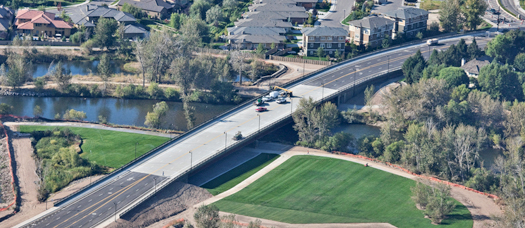
Excellence in Transportation Award:
Design: Large Project
Winner: East Parkcenter River Crossing

Participants:
CH2M HILL
Ada County Highway District (ACHD)
HDR Engineering Inc.
Sally Goodell (ACHD)
Colin Farr (ACHD)
Kent Brown (ACHD)
Greg Griffin (CH2M HILL)
Tobi See (CH2M HILL)
Robert Beckman (CH2M HILL)
East ParkCenter River Crossing:
providing a critical link in Boise’s transportation system
The East ParkCenter River Crossing (the Project) administered by Ada County Highway District (ACHD) is an ideal candidate for the Excellence in Transportation Award, Large Design Category. The planning and design development for this long-awaited transportation link provides motorists, riders, bicyclists, and pedestrians enhanced multimodal connectivity in this thriving commercial and residential community.
Traffic congestion and access to the east side of Boise were key drivers for the East ParkCenter River Crossing. This new alternative route crossing the Boise River decreases travel times, improves safety, and significantly reduces current congestion by redirecting heavy commuter traffic away from the historical Warm Springs area. Balancing competing interests is a challenge in any engineering project, particularly a high-profile example like the East ParkCenter River Crossing. A context-sensitive solution design approach equally considered safety, mobility, and the preservation of scenic, aesthetic, historic, environmental, and other community values.
The Project comprises a new urban roadway; five bridge structures; pedestrian
and bicycle paths; interconnection with utilities; wetland restoration and mitigation; Walling Ditch modifications; and integration with a local park, as well as residential and business developments. The CH2M HILL Project Team (Team) was challenged to apply innovative engineering techniques, materials, and equipment to protect the sensitive Boise River and surrounding wetlands; incorporate recreational opportunities; protect public safety; and offer an aesthetically pleasing bridge structure design.
The Team worked with ACHD to design a 420-foot-long, steel girder bridge; a 110-foot precast concrete bridge; and a 36-foot precast arch that supports a four-lane roadway. Two 14-footwide pedestrian tunnels were also designed to provide safe access under the roadway for pedestrians on the popular Boise River Greenbelt. The Project was designed with bicycle and walking paths to connect to existing pathways as well as planned pathways for the future Marianne Williams Park development, which will be located northeast of the project.
Balancing competing interests
Anticipated by the community for more than 30 years, this high-profile Project offered an excellent opportunity to showcase the benefits of a context sensitive solution (CSS) design approach to transportation design. The Team’s strong multidisciplinary background in transportation project engineering, bridge structure design, environmental studies, permitting, and public involvement provided the broad base of expertise necessary for incorporating CSS practices to meet ACHD’s needs and demonstrate the ability of a transportation project to be both sustainable and environmentally friendly.
Thinking outside the box
As a result of taking this sustainable approach, the Team was challenged to think outside of the traditional bridge ‘design’ form, including the unique application of different technology techniques, materials, and equipment. For example, the Team used a combination of precast concrete and cast-in-place methods on the bridge structures to shorten construction timeframes and protect the environment by allowing the Team to get in and out of the Boise River and other wetlands as quickly as possible.
For the girder placement on the Boise River structure, the contractor was challenged with finding a way to minimize river impacts; they responded with a different girder placement sequence, using a larger crane to completely avoid use of a crane pad within the riverbed.
Published 5-6-2011